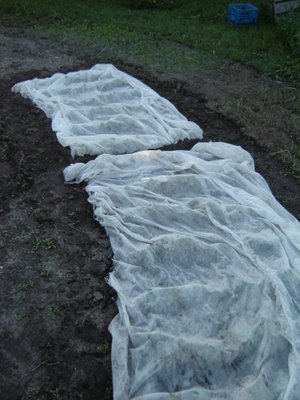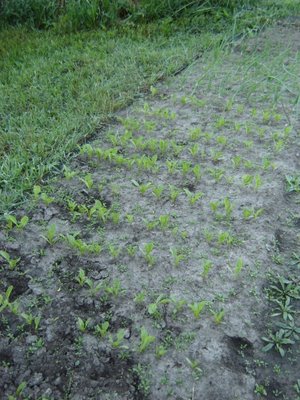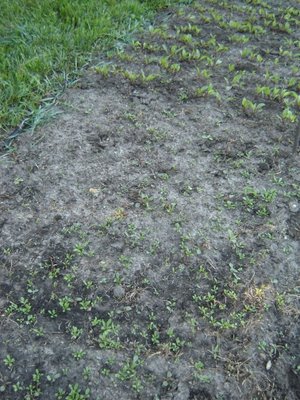Thursday, June 29, 2006
The South Squash
Labyrinth Location: Outer border arc, 12 o'clock
Vegetable: A winter squash
Seed/Transplant Date: June 5 or so
Soil Preparation: Rototilled lawn, with some grass rhizomes pulled out, and hills made with a shovelful of manure underneath
Okay, I admit it - I don't know what I planted here. I think it was either butternut or acorn squash. I'm calling them the south squash, until they show some evidence of their identity, but I'm not sure they'll get around to that. Here we are right around the solstice, and the shade above was just after noon. They've been coping with some grass pressure, too.
Grass is edible, eh?
But not very nourishing for a human, and not very good for nearby garden plants, either, I'm thinking. My impression is that some weeds can actually benefit the vegetables by loosening soil and bringing nutrients up from deeper levels, but grass doesn't help that way.
Wednesday, June 28, 2006
Time to Move the Rain Gauge
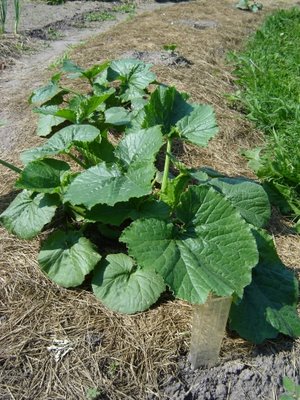
Labyrinth Location: 1st yin-dot arc, 10 o'clock
Vegetable: Zucchini
Seed/Transplant Date: May 22?
Soil Preparation: Existing garden, rototilled with well-rotted manure tilled in; hills made with a shovelful of manure underneath.
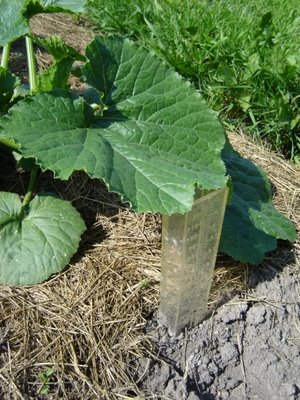
I don't know if it would work as a funnel, or as a roof, but I don't think that leaf would help the accuracy of the rain gauge.
B gave us a couple of big zucchinis already (and they were great in lasagna yesterday), but he got seedlings from a friend. Ours were started in the open. They have flower buds showing, so zucchini season is just around the corner.

They've grown a lot in two weeks.
Tuesday, June 27, 2006
Well, Pumpkins?

Labyrinth Location: 2nd yang-dot arc, 4 to 5 o'clock
Vegetable: Pumpkins
Seed/Transplant Date: June 5 or so?
Soil Preparation: Rototilled lawn, with some of the grass rhizomes pulled out, and hills made with a shovel-full of well-rotted manure under each.
I'm wondering if these pumpkins are well enough along to produce this year. I don't think I've ever grown a winter squash, of any kind, so it's very hard for me to judge. I think most people around here start their winter squashes indoors. That was my plan, too, but by the time it was indoor planting time for squashes, I was so discouraged with my other seedlings, I just didn't bother.
There are two hills of pumpkins in the picture, one directly behind the other, with a little patch of peas in between. We got tired of planting peas in the pea patch, and we had quite a bunch of them soaked and ready, so Garth took the extras and broadcast them on this new section of the garden. At that time, I wasn't sure if I'd be planting anything here, or just keeping it fallow to kill the grass. He raked them in a bit, but I could see a lot of them just sitting on top of the ground. Amazingly, nothing seemed to eat them. I found one that sprouted and grew, right out on the surface of the soil. Now I'm just letting them grow, as long as they don't crowd the squashes.
Here's the same piece of ground, from a slightly different angle, on June 14th. The near hill from the above picture is just right of centre in this one, with the second hill near the top left (in the not-yet-mulched area).
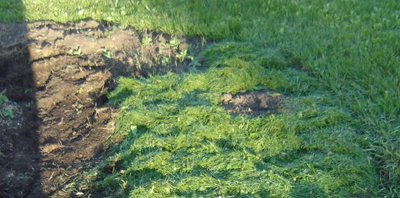
By Request . . .

. . . a closer-up picture of purslane (portulaca). Breathe deeply now - there's no need to send the weed inspector. This is part of our crop.
Here's a closer look at the flower, with an unfortunate blur/flare just where you'd like to see some detail.

Notice the fleshy leaves. The mucilaginous quality of this plant is said to make it a very good addition to soups and stews.
Here's one more close-up, of a plant that hasn't developed into a mat yet. You can see the way it branches out along the surface of the soil.

Monday, June 26, 2006
The Potato Portulaca and Pigweed Patch

Labyrinth Location: Not even close. Across the street.
Vegetable: Potatoes
Seed/Transplant Date: May 20?
Soil Preparation: Rototilled existing garden (borrowed space from bro-in-law).
Picked a pail a' portulaca . . .
. . . and it's quite tasty stuff, kind of lemony flavoured, but most of it is still in the fridge, waiting for me to try cooking Mexican Purslane Stuffing. Purslane is what you call it when you're planning to eat it. When you're getting hypertensive over any little sprig of it in the garden, you call it portulaca.
By the way, I think they left a step out of that recipe. They forgot to actually add the purslane. I'm guessing that happens right before you "saute until . . . the flavours marry."
I was introduced to purslane as a food by my dear friend Anita, just last summer. This year I was watching for it in my garden, and feeling rather sad that I hadn't found a single sprig. My mom is almost obsessive about cleaning out every last leaf, since even one tiny leaf can root and grow again. I guess I must have followed her teaching too well in the last couple of years.
Then I went across the street to check the potatoes. Bonanza! The ground was almost carpeted with it. Like I said, I picked an ice-cream pail full, and that was, oh, less than a third of the patch. And I wasn't picking the patch clean, either - leave some for next year, I figure!
I had bits of it on sandwiches and stuff, but before I could get 'round to cooking up that dish I linked above, I pulled a bunch of redroot pigweed from the yin-yang garden, and found another recipe: Stir-Fried Pigweed with Coconut (pdf). I was halfway through preparing the leaves, when I decided I didn't have enough, so across the street I went again to the patch of plenty. We had a great feed of stir-fried pigweed, and it was delicious - a delightful meal, except for the kids' reaction. After they had stirred up a heated argument and fried everyone's nerves, Ruth tried some and decided she liked it. James, on the other hand, declared that he will be doing all the cooking this summer.
Here is a wider view of the potato patch. There's an enormous volunteer spinach on the left, and the odd dill plant or radish scattered through. The larger darker potatoes in the middle distance are from purchased Pontiac seed potatoes, while the foreground is whatever variety we've been growing and eating for years - Netted Gems, maybe? The background area, behind that row of Pontiac potatoes, is B's garden.

And today I found a single purslane plant in the last untended corner of the yin-yang garden. I wonder. Should I break it up and spread it around a bit, for next year?
Sunday, June 25, 2006
The Yang Side
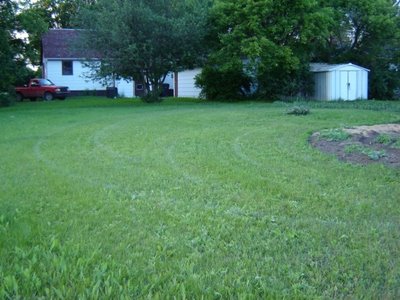
It's not really a bed, but I wanted to show you the yang side of my yin yang garden, now that I finally drew out the arcs of the labyrinth in the lawn. See the faint white lines? They're only marked with flour, so they're temporary. They are also nearly invisible when you look across the labyrinth at a low angle. When you actually walk it, you are seeing the lines close up and from above, so they show up quite well.
I walked it for the first time yesterday, and I found there was a very pleasant sense of arrival at a place of tranquillity when I reached the exit at the south end, looking out over the grassy expanse of the brick ponds. Then I walked back through it in the other direction, and found myself resisting, reluctant to follow this path back to the demands of daily life. Gradually I came to terms with it, though. When I emerged where I began, I felt a slightly uneasy thrill as I noticed that my hands were tingling. I used to get that same sensation after a good long session of Tai Chi.
I've been pausing from my gardening to gaze at it and wonder. If I remember correctly, a wide flat lawn area would actually be considered more "yin" than a gardenscape with its more complex surface including more vertical elements. Maybe the lawn part is actually the yin side. In that case, I believe I have it laid out backwards, since the yin side is supposed to lie mostly towards the south. (If you're thinking the black part of the symbol is mostly towards the top, you're right, but keep in mind that south is placed at the top of a map in Chinese traditions.) *UPDATE: Nope, I got that backwards. Yin, the black area, is mostly to the north. Feng shui expert I'm not. Here's a detailed discussion. I still haven't decided for sure which side of my labyrinth is really yin and which is yang. Maybe there's some wisdom in that.*
Oh well. This layout works better with the contour and soil conditions of my yard.
A school class might be coming to see the labyrinth tomorrow. I'll try not to talk too much about the philosophy. They might like to hear about how I made it. Here you see me marking the lines, using a rope tied to a peg to guide the "limer" (borrowed from the school) along an arc.
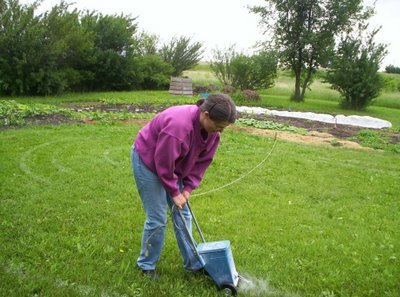
This arc, drawn with the rope staked at the centre of the whole design, is what I refer to as a "border arc," because it is stepped in from the border of the design. Just behind me in the picture, you can see some tighter arcs that were drawn with a rope staked at the centre of the yin dot (which is hidden behind me). I call these the yin-dot arcs. At the right edge of the picture, closer to the garden, I drew some yang-dot arcs. The only tricky part was remembering which arcs had to join up, and where, so that I didn't extend any arcs too far.
Armed with this new information, you might be able to figure out my "Labyrinth Location" codes. Some tricky points: I number the border arcs inward from the outside, but I number the dot arcs outward. Points of the clock refer to one of three different imaginary clock faces. If we are talking about a dot arc, the clock face is centred on the corresponding dot. If we are talking about a border arc, the clock face corresponds to the entire design. And finally, since south is at the top of the yin yang symbol, 12 o'clock means south. Clear as mud? Good.
I know, I need a diagram. Soon. Well, that is to say, maybe this winter.
Saturday, June 24, 2006
Just Spinach

Labyrinth Location: 2nd yin-dot arc, 11 o'clock
Vegetable: Spinach
Seed/Transplant Date: May 23 (?)
Soil Preparation: Existing garden, rototilled with well-rotted manure tilled in
Freshly mulched with grass clippings from the collecting basket on the reel-type mower. I've let the lawn get too long again, so I'll have to switch to the gas mower for the rest of it . . . sigh . . . but I'm always learning. I noticed that it really doesn't take much gas to do the whole yard, and yet it saves a rather large amount of effort. It boggles my mind to think of how much energy I use up with every gallon of gas. It's far more precious stuff than its price would indicate.
Maybe it's time to learn to sharpen the scythe, and swing it just right. When I was a teenager, I could swing it well enough to mow down a waist-high tangle of weeds and poplar suckers, but I'm thinking it would take a little more skill to mow just an inch or two off the lawn. And then I'd have to rake it, too. Maybe it's time to learn some discipline and use the reel-type mower a little more often.
Friday, June 23, 2006
Under Wraps

Labyrinth Location: 2nd border arc, 12 o'clock
Vegetable: Broccoli and Cauliflower
Seed/Transplant Date: When did I set these out? I think it was around June 5th.
Soil Preparation: Variable. Mostly just tilled up lawn. I don't think I even added any manure to this part.
While I was cleaning up under the row cover yesterday, I dug a lot of grass out from around the broccoli and cauliflower. The soil smelled so nice and rich - I don't know if that means it's healthy, or if the decaying lawn residue might be stealing nitrogen at this point. But I did notice that there was a wonderful warm moist microclimate under that row cover.
Mom grew these transplants for me - aren't they lovely? This one is just starting to form some florets.

Thursday, June 22, 2006
Taking a Peek
Labyrinth Location: 2nd border arc, 11 o'clock
Vegetable: Rutabagas (Swede Turnip)
Seed/Transplant Date: May 21 or 22 (?)
Soil Preparation: Existing garden, rototilled with well-rotted manure tilled in.
Have you been wondering what's under the white stuff? All my cabbage-family plants. Mom gave me the floating row covers, and I stitched two lengths together side by side to make a wide enough cover for my three-foot-wide beds.
I was forewarned to leave quite a bit of slack in the cover so the plants don't push it up and lift the buried edges free of the soil. The wind moves the cover around quite a bit, so there are often layers of folded material lying over the plants, but they don't seem to mind. I've been watching the dim green lumps get larger, and itching to get a good look at this vigorous growth...
At first I didn't have enough row cover, so I left about six rows of turnips exposed. Mom found some more cover stashed away, and I headed for the garden, armed with a needle and thread to hand-sew the new piece onto the end of the old.
The flea beetles were there ahead of me.
I put the needle and thread away, and got out the battery-powered vacuum cleaner. Up and down the bed I went, sucking up the tiny blue-black beetles wherever I saw them, back and forth until I didn't see any more. Then I put the new row cover on, but instead of attaching it to the first piece, I buried the edges separately (as you can see above). I didn't want to release any beetles I'd missed into my original covered bed. It meant disturbing the soil rather close to the roots between two rows of turnips, but I had to take one chance or the other.
Well, it looks like I cleaned out the flea beetles pretty well; either that or the plants were almost beyond being vulnerable. They grew vigorously with very little further damage. Today I decided to unearth the row-cover edges from between those two rows, while I could still do it without too much root disturbance. Hand-stitching the edges together was a more gruelling task than I'd anticipated. In hindsight, I might have just dug the whole thing up and taken it in to the sewing machine, but then again, I did see a white butterfly flitting around the edges of the garden as I worked. Bending over, reaching, trying to hold the layers straight and taut by putting my toe on one spot and gripping another, and then trying not to catch extra folds with the needle . . . I didn't have the patience to make a fine seam. I hope the flea beetles or cabbage butterflies (or whatever it is I'm keeping out) aren't too persistent at looking for a gap.
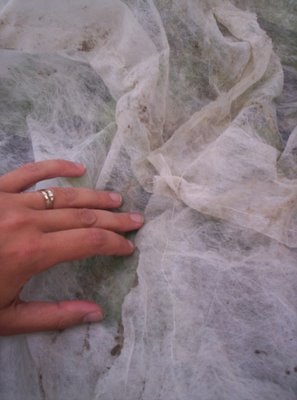
Ah, the suspense. Yes, I did pull the cover loose all the way up one side of the bed to do some weeding and thinning. Wow! I've never grown such a blanket of turnips. In fact, I'm not sure I've ever successfully grown a turnip at all.
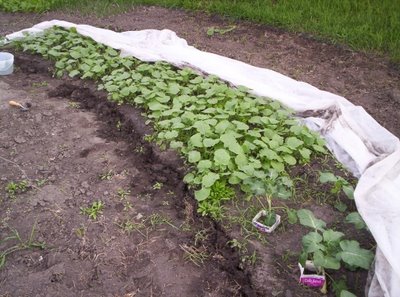
But I didn't dare leave them like that. I've been trying to convince myself to leave things thicker, and thin them gradually just enough to keep them looking happy. Under the row cover, though, I can't really see what's going on, and with the fuss of uncovering and re-covering, I just might procrastinate too much.
So I thinned them.

Now, who is going to eat all those greens?
What does one do with turnip greens? "...country as a turnip green..." - I know the song, but I don't know what it means. Somehow in all the excitement of learning how to garden, I overlooked the importance of learning how to cook.
Wednesday, June 21, 2006
Even More Patience than Parsnips

Labyrinth Location: 3rd border arc, 10 o'clock
Vegetable: Parsley
Seed/Transplant Date: May 25 or so?
Soil Preparation: Existing garden, rototilled with well-rotted manure tilled in.
Looks like an empty bed, doesn't it? The only things that look like rows are the borders of weeds?
But they're there - I found them peeking out from under the shepherd's-purse umbrellas just the other day.
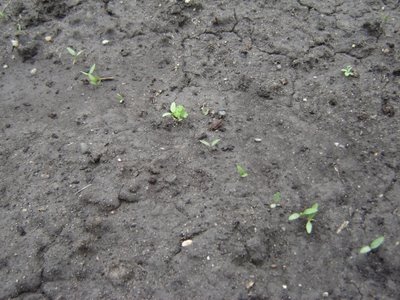
I don't quite remember when I planted them. I think it was just a few days after my main planting spree. I remember that I left them to soak and forgot about them, so instead of a 24-hour soak it was more like 48. But they still seemed alive to me; in fact, they seemed on the verge of sprouting, so I was optimistic about a fast start. Then as the weeks went by, I wondered if I'd killed them. But I guess they're just very slow.
Tuesday, June 20, 2006
Cleaning Up the Carrots
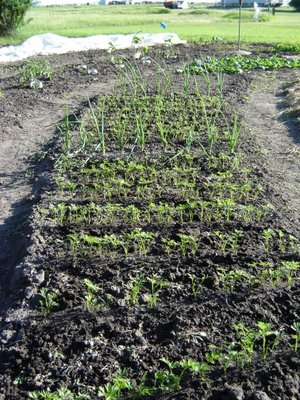
Labyrinth Location: 2nd yin-dot arc, 10 o'clock
Vegetable: Carrots
Seed/Transplant Date: May 22 (?) - Danvers and Touchon; June 8 (?) - Nantes replanted.
Soil Preparation: Existing garden, rototilled with well-rotted manure tilled in.
I'm sure glad I decided to try several varieties of carrots, instead of relying on my large store of leftover Nantes seed of uncertain age. The old seed was a total failure, so I replanted with a packet of Nantes from the grocery store. We'll see how well they catch up.
 Like many beds, I planted this one with a fairly close row spacing, planning to mulch to control weeds. Until I get that mulching done, I have some finicky weeding to do between the rows. One of my favourite garden tools so far, during this wide-bed experiment, is this one.
Like many beds, I planted this one with a fairly close row spacing, planning to mulch to control weeds. Until I get that mulching done, I have some finicky weeding to do between the rows. One of my favourite garden tools so far, during this wide-bed experiment, is this one.It's marketed as a crack weeder, but I use it as a miniature hoe.


The replanted Nantes carrots are up.

And here is how the carrot beds looked five days ago.
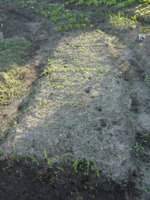

Monday, June 19, 2006
A Whole-Garden Day

I worked in a lot of different beds today, wherever there was lots of room for my hoe. Up and down the paths, too. I was thinking I should try to do more interplanting next year, so there isn't so much empty space between plants, but I suppose it will fill in a lot. And if there was less empty space, I'd have to do more hand weeding.
I haven't done as much mulching as I'd like. First I was busy just getting it planted, and then I was weeding and thinning in the rows, leaving the hoeing and mulching till later. But yesterday Garth started in with the hoe, and I got anxious about doing it my way. Besides, he was right - it was time.
It looks a lot better this evening, overall. I was out at a meeting and didn't get a picture until dusk, but you get the idea.
I borrowed a "limer," for marking lines of lime (or flour) on athletic fields and race tracks and so on. I'm going to mark out the lawn half of the labyrinth with it. Watch for a picture soon.
Poetry of the Hoe
I was hoeing in the hot sun
most of the morning but there's
method to my madness.
I want those wounded weeds well wilted
ahead of the healing hands of
darkness and dew or
another
round of rain.
most of the morning but there's
method to my madness.
I want those wounded weeds well wilted
ahead of the healing hands of
darkness and dew or
another
round of rain.
Sunday, June 18, 2006
Wind-Whipped Chard
Labyrinth Location: Outer border arc, about 10 o'clock
Vegetable: Swiss Chard
Seed/Transplant Date: May 22 (?)
Soil Preparation: Existing garden, rototilled, with well-rotted manure tilled in.
A side note about the construction of the yin-yang garden design: the lawn at the left of the photo above is transplanted sod, where I grassed a corner of the existing square garden. The topsoil went to fill new beds where I had taken out sod.
The chard has given us several small harvests of thinnings already. They're quite nice in a salad or a sandwich. The bed is due for a thinning again.

I'll try to thin out the plants that are growing flopped over at the base. I don't know why, but certain plants lie over sideways a bit and then turn up. In a wind, they get whipped around a lot (as I noticed while weeding in a very gusty spell yesterday), whereas other plants grow straight up and the wind doesn't seem to bother them. Something about planting depth? Soil disturbance after sprouting? Just luck?


Saturday, June 17, 2006
Peas, Peas, Pretty Peas
Labyrinth Location: Inner yin-dot arc, 6 to 9 o'clock
Vegetable: Peas
Seed/Transplant Date: May 21 (?), and June 7
Soil Preparation: Same as the Yin Dot.
When I started this blog, just three days ago, I walked through the garden and photographed every bed. I'm amazed already at the change that's noticeable between those June 14th photos and today.

Garth made sure we got these planted as early as possible - well, actually, as early as he could persuade me to interrupt my digging for some planting, which wasn't early at all. (Deb in Minnesota has peas flowering already!) I gave them a prime spot in the new part of the garden, hand dug with the sod swapped out with existing garden soil. Not that I wanted to favour them - in hindsight, I might have found a way to put parsnips and carrots in this nice deep soil - but I wanted to keep the legumes away from where I'd grown them before, to see if the germination would be better.
It was, but only marginally. I had new seed, too, whereas last year I had planted three-year-old seed of very uncertain quality, stuff that Garth had collected from our own garden when the crop got ahead of us and dried on the vines. Maybe I shouldn't be soaking the peas before planting? The seed envelope suggests using a fungicide if spotty germination has been a problem, but I'm wondering if there are other things I could try instead.
The snow peas I planted were old seed, and didn't grow at all. I got some more seed of the regular (Lincoln Homesteader) peas, and replanted the snow pea bed plus the gaps in the regular peas. They're just coming up today. That should extend the harvest a little.

Friday, June 16, 2006
Parsnips Take Patience
Labyrinth Location: Outer border arc, 9 o'clock plus.
Vegetable: Parsnips
Seed/Transplant Date: May 22? No later.
Soil Preparation: Less than ideal. Converted from lawn with a rototiller, and a few shovelfuls of well-rotted manure tilled in.
Two days ago, I could barely pick out the rows of tiny seedlings among the weeds. Can you? They're there, in the photo above. (No, not those things in the background; those are beets. Planted at the same time.)
It was only in the last week or so that I found the first sprouts. Parsnips take patience; it says so in the Harrowsmith Northern Gardener, but I had already figured it out for myself before I read that. I'm sure I hadn't read the parsnips entry before, or I wouldn't have planted them in this bed. It's constantly growing up in grass from the bits of rhizome that the tiller didn't kill. Some other converted-lawn beds that I deep dug by hand are almost grass free, and probably loose to a greater depth, too, which would have been good for the parsnips. I didn't do a lot of figuring where to plant things this year; it was getting late, and I had to resort to the "just do it" principle to get it done. (So I can't complain too much about the rototilling.) Next year I'd like to plant these a lot earlier.
Parsnips have been an on-again, off-again crop for me in the past, but I think it was the patience that was lacking. I pretty much planted things, walked away, and didn't give the garden much attention until I could see some things to weed around. That might work with peas and lettuce, but by the time the poor parsnips got going, the weeds usually had a terrific head start. Another difference this year: I've been trying to keep the beds well watered until the seedlings show up. (I love my new rain barrels.)
On the topic of parsnips - last fall Mom forgot to ask me to dig her parsnips while she was away. In fact, she completely forgot about them, until this spring. They hadn't been mulched or anything. She dug them up, and they were perfect. Delicious. When someone says "harvest with an ice pick," they mean it.
I couldn't find the camera earlier today, and then I got . . . busy, and then it was supper and a band rehearsal, and then dark. I found the camera, barely found my way out to the garden (almost walked in it), used the faint light from the camera's view screen to make sure I'd located the parsnips, and tried a little pointing and shooting. Point, shoot, look at the screen to see what the flash found for me; point again.
There they are!

Some are getting more of a parsnip look.

But just a couple of days ago, a pair of parsnip cotyledons could hide very nicely among the leaves of this weed. (Sorry for the blur - a lot of my in-the-dark photos turned out like that.)

I think if I let it grow, this weed would turn out to be shepherd's-purse. The garden was thick with it when we bought the place. Over time, we were getting the edge on the seed bank, I thought - more withdrawals than deposits. Then last summer I was away or busy or something, and Garth kindly zipped through the garden and pulled most of the big weeds. Trouble is, he just dropped them where he found them . . . seed pods and all.
Thursday, June 15, 2006
I Just Weeded This!
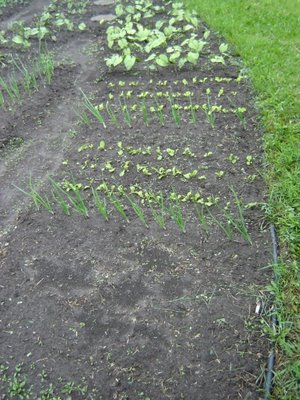
Labyrinth Location: Outer border arc, 9 o'clock
Vegetable: Lettuce
Seed/Transplant Date: Grand Rapids and Salad Bowl: May 21 or 22, I think; definitely no later. Cimarron Red Romaine: same date, but almost total failure (old seed); replanted around June 8.
Soil Preparation: Same as the Yin Dot.
Yesterday I cleaned up this bed for its debut here. This morning I went out to take its picture in the best light, and . . . just look at all the green between!
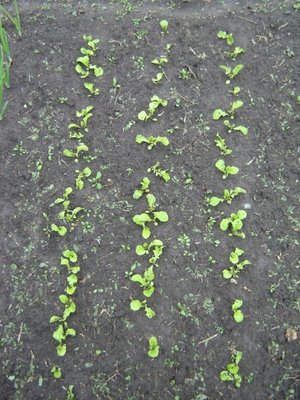
Of course, I can't complain about the rain last night, even if it did help those weeds re-root.
I could have planted lettuce a lot earlier, but I didn't have the ground ready. (Next year.) I planted all my lettuce at once, rather than in succession, thinking it might soon be too warm for good germination. But my romaine lettuce seed turned out to be too old - I only found two seedlings - so I got some new seed, and did a late planting after all. Last week's cool rainy weather was perfect for it, and I have good thick rows of romaine sprouting now. They don't show up in the photo, but they're in the bare area in the foreground (top photo).
There are three varieties of lettuce, with rows of onions in between. I used onion sets to mark boundaries between similar vegetables, because they sprout quickly, and because it's good to plant onions throughout the garden to discourage pests (or so I'm told). Unfortunately, they didn't discourage whatever it was that munched off the larger of my two original romaine seedlings. A jackrabbit? I've never noticed any lettuce losses before this year, but I know there are jackrabbits around. Maybe I shouldn't have planted the lettuce so close to the caragana hedge.
Wednesday, June 14, 2006
No Beginning and No End
Labyrinth Location: The Yin Dot
Vegetable: Chives and Tree Onion
Seed/Transplant Date: Early May (transplanted from another part of the garden)
Soil Preparation: Sod stripped about 7 cm deep. Soil underneath loosened with shovel. Sod replaced with existing garden soil, which had already had well-rotted manure tilled into it.
Where to begin? One of the principles of Tai Chi is that there is no beginning and no end. It is fitting, then, that there be no obvious place to begin a tour of this garden. But since I have to choose a spot, I think it is fitting to start with the yin dot in the middle of the yang part of the design. This dot represents the idea that although yin and yang are different, each one contains a seed of the other. So this yin-dot bed will be the seed of my garden blog.
I put my perennials here, thinking it would be easier to protect them from reckless tillage. Somehow it seems meaningful, too; they are part of the cultivated part of the design, and yet, their perennial habit gives them something in common with the grass of the lawn.
There is a barrier of plastic lawn edging to keep the grass out of this little circle, and inside it a row of bricks for the mower wheel to run on, so that it can mow right to the edge and not leave a fringe of grass needing trimming.
The steel post in the centre is temporary, just anchoring my arc-layout rope. A barn swallow likes to sit on it and sing at me. As long as he doesn't get more aggressive than singing, I'm happy to have him around eating mosquitoes. His nest is in my toolshed, though, so I'm a little worried.
Also in the centre, hiding among the chives, are two tree-onions from Mom and Dad. Last year they struggled among weeds beside the tree that grew in our garden (yes, in it), and they barely managed a few leaves. This spring, when we dug out the tree stump, we transplanted one tree-onion and overlooked the other. It somehow endured all our digging, plus some rototilling, and still managed to get a leaf up and catch my attention in time to be rescued and moved into this bed. It isn't as large as the one that was transplanted directly, but it's doing fine.
The larger one is already working on a second generation, with bulblets sprouting new plantlets on top of it.

Introducing "The Daily Bed"
If you've been reading Arcol-o-Gist, you may have seen my posts there about designing a Tai Chi Labyrinth, and the evolution of that design into my Tai Chi Labyrinth garden. You may also have seen some posts about trying to grow more of my own food, to reduce my use of fossil fuels and the associated impacts on oceans, climate, native prairie, nutritional content of food . . . okay, I'm getting off the topic already.
I am writing this blog as a discipline, to focus more of my attention, more regularly, on gardening. My aim is to feature one garden bed each day, regardless of whether I have one ready for public viewing or not. But just in case you're thinking I'm possessed by a Babylonian demon that's demanding rigidly scheduled productivity: I won't present the beds systematically, but in the order that they themselves demand my attention. So there.
And in case you're wondering what's of interest here for you: remember, this is no ordinary garden. It's a Tai Chi Labyrinth garden, probably the only one in existence, anywhere; and at the same time, it's an attempt to grow a serious quantity of food in a fairly small area, in a northern climate.
If the Tai Chi Labyrinth angle interests you, perhaps you'll want to just read the rest of this introductory overview, and then wait until I develop a virtual walkthrough (probably this fall, after gardening season; I'll add a link in the sidebar when it's done).
If serious food production in a northern climate is your interest, I don't have a lot of the wisdom of experience, but I hope that this diary will gradually become a storehouse of detail on what I did, when and how, what worked, and what didn't. You're welcome to follow along on this beginner's journey and see what I learn along the way.
Now, before we get started, here is an overview of what this Tai Chi Labyrinth garden is all about.

The garden beds make up one half of a Tai Chi symbol, or yin-yang: the half which is coloured black, representing yin. The paths between the beds are actually one long continuous path, winding back and forth as a labyrinth for meditative walking. A few stepping stones are strategically placed to allow shortcuts through the design for garden maintenance.

Someday the path will extend out into the adjacent lawn area as well, tracing its meanders through the yang portion of the design, which at present is left to the imagination. (At one point I had hoped to fill the whole symbol with garden, but I was told I couldn't have that much of the yard.) Aside - I'd like to find about 800 of the original Arcola bricks (made at the brick plant just a stone's throw southeast of our present yard), bring them home to the earth they came from, and set them into the ground as path outlines.
I had not anticipated how very attractive the garden would be, especially the "S"-shaped border through the centre of the design.
 (Eventually that whitish thing where the yang dot should be will be replaced by a dot of grass - buffalo grass, so I can be sure of controlling its spread. If you're wondering what the whitish thing is, it's a discer blade that spent some time in the role of a bird-bath basin, but now the bird bath is upside down, and its post is serving nicely as an anchor for the rope I use to lay out arcs.)
(Eventually that whitish thing where the yang dot should be will be replaced by a dot of grass - buffalo grass, so I can be sure of controlling its spread. If you're wondering what the whitish thing is, it's a discer blade that spent some time in the role of a bird-bath basin, but now the bird bath is upside down, and its post is serving nicely as an anchor for the rope I use to lay out arcs.)
Another thing I hadn't anticipated is the power of that curving path, beckoning me into the garden.

On the downside, I hadn't expected to have so many family members trying to correct this part of my design for me. (At least they're interested!)
 I try to explain that the garden beds, although wide, are actually lines outlining paths, and at this spot, the outside line has to change from garden to grass to begin the yang part of the symbol. Someday I will publish details of the geometric construction of the design, and it will all make sense. Trust me, it's elegant. That's what drove me to build it - the amazingly simple layout process that somehow fell into my mind. If it weren't for that, I would still be fiddling with sketches and dreaming about next year.
I try to explain that the garden beds, although wide, are actually lines outlining paths, and at this spot, the outside line has to change from garden to grass to begin the yang part of the symbol. Someday I will publish details of the geometric construction of the design, and it will all make sense. Trust me, it's elegant. That's what drove me to build it - the amazingly simple layout process that somehow fell into my mind. If it weren't for that, I would still be fiddling with sketches and dreaming about next year.
Here is what the garden looked like overall, first thing this morning.

Now, on to the first bed!
I am writing this blog as a discipline, to focus more of my attention, more regularly, on gardening. My aim is to feature one garden bed each day, regardless of whether I have one ready for public viewing or not. But just in case you're thinking I'm possessed by a Babylonian demon that's demanding rigidly scheduled productivity: I won't present the beds systematically, but in the order that they themselves demand my attention. So there.
And in case you're wondering what's of interest here for you: remember, this is no ordinary garden. It's a Tai Chi Labyrinth garden, probably the only one in existence, anywhere; and at the same time, it's an attempt to grow a serious quantity of food in a fairly small area, in a northern climate.
If the Tai Chi Labyrinth angle interests you, perhaps you'll want to just read the rest of this introductory overview, and then wait until I develop a virtual walkthrough (probably this fall, after gardening season; I'll add a link in the sidebar when it's done).
If serious food production in a northern climate is your interest, I don't have a lot of the wisdom of experience, but I hope that this diary will gradually become a storehouse of detail on what I did, when and how, what worked, and what didn't. You're welcome to follow along on this beginner's journey and see what I learn along the way.
Now, before we get started, here is an overview of what this Tai Chi Labyrinth garden is all about.

The garden as it appeared on May 31st.
The garden beds make up one half of a Tai Chi symbol, or yin-yang: the half which is coloured black, representing yin. The paths between the beds are actually one long continuous path, winding back and forth as a labyrinth for meditative walking. A few stepping stones are strategically placed to allow shortcuts through the design for garden maintenance.

Someday the path will extend out into the adjacent lawn area as well, tracing its meanders through the yang portion of the design, which at present is left to the imagination. (At one point I had hoped to fill the whole symbol with garden, but I was told I couldn't have that much of the yard.) Aside - I'd like to find about 800 of the original Arcola bricks (made at the brick plant just a stone's throw southeast of our present yard), bring them home to the earth they came from, and set them into the ground as path outlines.
I had not anticipated how very attractive the garden would be, especially the "S"-shaped border through the centre of the design.
 (Eventually that whitish thing where the yang dot should be will be replaced by a dot of grass - buffalo grass, so I can be sure of controlling its spread. If you're wondering what the whitish thing is, it's a discer blade that spent some time in the role of a bird-bath basin, but now the bird bath is upside down, and its post is serving nicely as an anchor for the rope I use to lay out arcs.)
(Eventually that whitish thing where the yang dot should be will be replaced by a dot of grass - buffalo grass, so I can be sure of controlling its spread. If you're wondering what the whitish thing is, it's a discer blade that spent some time in the role of a bird-bath basin, but now the bird bath is upside down, and its post is serving nicely as an anchor for the rope I use to lay out arcs.)Another thing I hadn't anticipated is the power of that curving path, beckoning me into the garden.

On the downside, I hadn't expected to have so many family members trying to correct this part of my design for me. (At least they're interested!)
 I try to explain that the garden beds, although wide, are actually lines outlining paths, and at this spot, the outside line has to change from garden to grass to begin the yang part of the symbol. Someday I will publish details of the geometric construction of the design, and it will all make sense. Trust me, it's elegant. That's what drove me to build it - the amazingly simple layout process that somehow fell into my mind. If it weren't for that, I would still be fiddling with sketches and dreaming about next year.
I try to explain that the garden beds, although wide, are actually lines outlining paths, and at this spot, the outside line has to change from garden to grass to begin the yang part of the symbol. Someday I will publish details of the geometric construction of the design, and it will all make sense. Trust me, it's elegant. That's what drove me to build it - the amazingly simple layout process that somehow fell into my mind. If it weren't for that, I would still be fiddling with sketches and dreaming about next year.Here is what the garden looked like overall, first thing this morning.

Now, on to the first bed!
Subscribe to:
Posts (Atom)



